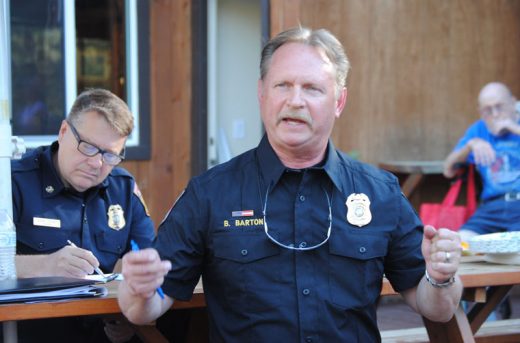
Questions about first responders’ preparation for evacuations, which may be mandated during disasters, such as wildfires, were raised in two public meetings this week.
Both the Riverside County Board of Supervisors and the Idyllwild Fire Protection District (IFPD) Commission addressed their agencies’ planning for potential evacuations.
Idyllwild couple, Sue Nash and Tom Paulek, were at the IFPD meeting. They stated their worries were formed after learning of the Camp Fire disaster last summer in Paradise. They expressed concern about the adequacy of planning for an emergency and specifically if an evacuation was needed. They have requested a copy of the plan to allay their fears. More details are in the IFPD story on page A1.
Before the supervisors began working on their agenda for the July 23 meeting, Third District Supervisor Chuck Washington addressed the issue and asked Bruce Barton, director of the county’s Emergency Management Department (EMD), to brief the rest of the board about the process of evacuation planning.
“The Idyllwild community has expressed concern that, with all the road work going on, community members would not be able to escape the hill should another fire occur,” Washington said as he introduced the topic.
“I want to assure you that the county has been working to provide the community with useful information, and while at the same time, keeping the community safe and secure,” he added.
While the last officially approved Emergency Operation Plan (EOP) was 2006, Washington wants the community to know that the public safety agencies are constantly evaluating and modifying this document.
Barton then discussed what his organization, in cooperation with fire and law enforcement officials, does to ensure the community’s safety.
He identified several documents starting with the county ordinance. At the top is the county’s EOP. These documents move from general process and responsibilities to more local and specific plans and options. Among the other documents are the “Emergency Operations Center Plan,” the “Local Hazard Mitigation Plan,” the “Mass Care and Shelter Plan,” the “Concept of Operations Plan,” and the incident action plans.
The EOP, originally adopted in 2006, has been revised and will be presented to the supervisors at the Aug. 6 meeting. Among its topics are methods for conducting an emergency response, how resources are mobilized, and how to inform the public and others.
The evacuation process planning starts early, before a disaster starts, he stressed. Consequently, “it is a very fluid process,” Barton said. “It’s very dynamic and dependent upon situational awareness.”
A specific immutable plan would be impractical, he and fire officials have said often. While general plans and actions are identified, their implementation depends upon the fire’s behavior, fire history in the area, what is happening on the ground, and weather, including wind.
While there is a Mountain Area Safety Taskforce (MAST) plan, covering hill areas, Barton stressed that it is a pre-plan with tactical details.
“There is a lot of tactical detail that does not enhance the public’s knowledge for what an evacuation would be,” he said.
For example, “It contains equipment staging locations, possible incident command post locations, potential helicopter landing locations, water locations and contact information for increasing water pressure and other, tactical level information,” Barton explained in an email. “This fire pre-planning document is intended for reference by incident commanders who would use it in conjunction with real time fire behavior, location and other environmental conditions to select the safest evacuation routes and subsequent orders issued to residents.”
Consequently, both Barton and Chief Mark LaMont of IFPD have denied requests for public access to this document.
“There is great risk to public safety personnel and the public should the information contained in the MAST plan be misused or misinterpreted,” Barton wrote in an email to the Town Crier. “Therefore, because of this, we elect to exercise the public interest exemption to the California Public Records Act. We strongly believe that the public interest in not making the record public outweighs the public interest served by disclosure of the record.”
He assured the board that the responsible agencies ⎯ Cal Fire, Forest Service, IFPD, California Highway Patrol, the Sheriff’s Department and EMD ⎯ are continually reviewing their plans and working with Cal Trans on the conditions and availability of the local highway arteries, highways 74 and 243.
The hill’s evacuation map showing the evacuation zones can be found on the RivCoReady webpage at https://rivcoready.org/stormready.
If another emergency did occur, residents can use AlertRivCo for access to the reverse 911 system message, EMD’s Facebook and Twitter accounts, or listen to local emergency radio station WNKI-AM 1610.
To sign up for emergency alerts, go to www.rivcoready.org/AlertRivCo.
Barton reminded the board that EMD had planned and organized 10 evacuations in the county in the past two and half years. This includes the Cranston and Holy fires last summer.










